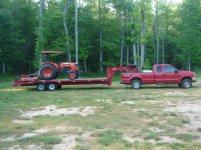As previously stated:
Balance the load. Inflate the tires to maximum. Also, make sure the hitch height makes the trailer tongue level when the trailer is loaded. If it is not, you'll be unloading the rear tires on the trailer, and loading the front tires making it more prone to sway.
Now some comments...I've pulled a variety of trailers over a 30 year period including enclosed trailers, large boats, and equipment trailers. My current towing vehicle is an F350 diesel crew cab dually with the Tow Boss package. I also have air lifts on the rear to level the vehicle if needed.
My humble opinion is that weight distributing hitches are a crutch for those that can't or won't load their trailer with the proper percentage of tongue weight.
If you haven't used a weight distributing hitch - your opinion is worth zero - no matter how "humble" it may be. I use a WDH on trailers as it helps bring the vehicle to level, provides better steering ability, and makes the trailer far more controllable in a cross wind. You may be as macho as you want about how to load a trailer, but, if you pull any kind of load or one with a high cross sectional area - the WDH makes driving a lot easier. My motto - don't work hard, work smart.
Why not just get a GN then
Makes a lot of sense for regular use, and little sense for occassional use. I pull my 18-foot deck equipment trailer only 5-6 times per year. I just pulled it on a 560 mile round trip with my JD 3320 with a loader and backhoe. The tractor has loaded front and rear tires - so my guesstimate is the weight is in the 6,000 pound area including the tool box, binders, chains, etc. The trailer is rated for 9,999 pounds but, is built on a 14K frame with 11K worth of axles and brakes on all 4 wheels.
On the return trip, there was a constant 25mph cross wind with gusts to 35mph. I set the cruise control on 72mph and had no trouble maintaining stability and control specifically because of the WDH. Everyone doesn't need a gooseneck.

